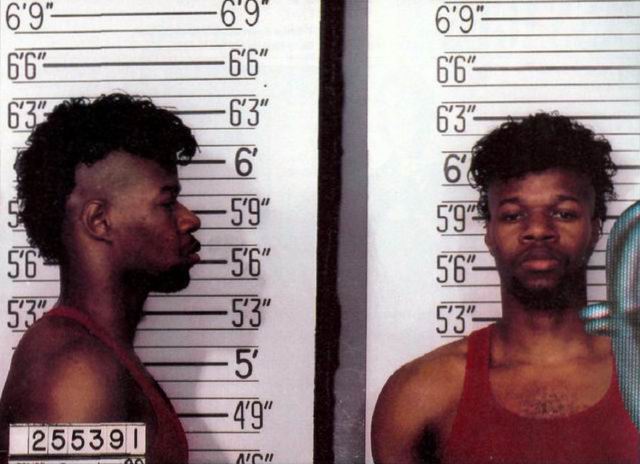The Mitch Thomas Show
The Mitch Thomas Show debuted on August 13, 1955, on WPFH, an unaffiliated television station that broadcast to Philadelphia and the Delaware Valley from Wilmington.
10 Born in West Palm Beach, Florida,
Mitch Thomas graduated from Delaware State College and served in the army before becoming the first black disc jockey in Wilmington, Delaware, in 1949.
11 His television show, broadcast every Saturday, resembled Philadelphia's
Bandstand, at the time a local program hosted by
Bob Horn, and other locally broadcast teenage dance programs.
The Mitch Thomas Show stood out because it was the first television show hosted by a black deejay that featured a studio audience of black teenagers. Otis Givens, who lived in South Philadelphia and attended Ben Franklin High School, remembered that he watched the show every weekend for a year before he finally made the trip to Wilmington to dance on air. "When I got back to Philly, and everyone had seen me on TV, I was big time," Givens recalled. "We weren't able to get into
Bandstand, [but]
The Mitch Thomas Show gave me a little fame. I was sort of a celebrity at local dances."
12 Similarly,
South Philadelphia teen Donna Brown recalled in a 1995 interview, "I remember at the same time that Bandstand used to come on, there used to be a black dance thing that came on, and it was The Mitch Thomas Show . . . And that was something for the black kids to really identify with. Because you would look at Bandstand and we thought it was a joke."13 The Mitch Thomas Show also became a frequent topic for the black teenagers who wrote the
Philadelphia Tribune's "Teen-Talk" columns. Much in the same way that national teen magazines followed
American Bandstand, the
Tribune's teen writers kept tabs on the performers featured on Thomas's show, and described the teenagers who formed fan clubs to support their favorite musical artists and deejays.
14 The fan gossip shared in these columns documented the growth of a youth culture among the black teenagers whom
Bandstand excluded. In 1957, it was one of these fan clubs that made the most forceful challenge to
Bandstand's discriminatory admissions policies.
15 Although many of these teens watched both
Bandstand and Thomas's show, as
Bandstand grew in popularity and expanded into a national program,
The Mitch Thomas Show remained the only television program that represented the region's black rock and roll fans.
Economics, more than a concern for racial equality, influenced WPFH's decision to provide airtime for this groundbreaking show. Eager to compete with
Bandstand and the afternoon offerings on the other network-affiliated stations, WPFH hoped that Thomas's show would appeal to both black and white youth in the same way as black-oriented radio.
16 The station's bet on Thomas was part of a larger strategy that included hiring white disc jockeys Joe Grady and Ed Hurst to host a daily afternoon dance program that started at 5 p.m., after
Bandstand concluded its daily broadcast. While
The Grady and Hurst Show broadcast five times per week, the weekly
Mitch Thomas Show proved to be more influential.



Drawing on Thomas's contacts as a radio host and on the talents of the teenagers, the program helped shape the music tastes and dance styles of young people in Philadelphia. In a 1998 interview for the documentary
Black Philadelphia Memories, Thomas recalled that "the show was so strong that I could play a record one time and break it wide open."
17 Indeed, Thomas's show hosted some of the biggest names in rock and roll, including
Ray Charles,
Little Richard, the
Moonglows, and
Frankie Lymon and the Teenagers. It also featured vocal harmony groups from the Philadelphia area.
18 Thomas promoted large stage shows as well as small record hops at skating rinks.
19 These events were often racially integrated, "The whites that came, they just said, 'Well I'm gonna see the artist and that's it.' I brought Ray Charles in there on a Sunday night, and it was just beautiful to look out there and see everything just nice."
20
Ray Smith, who attended
American Bandstand frequently and has done research for one of dikk Clark's histories of the show,
remembers that he and other white teenagers watched The Mitch Thomas Show to learn new dance steps. Describing the "black Bandstand," Smith recalled:
First of all, black kids had their own dance show, I think it was on channel 12, but one of the reasons I remember it is because I watched it. And I remember that there was a dance that [American Bandstand regulars] Joan Buck and Jimmy Peatross did called "The Strand" and it was a slow version of the jitterbug done to slow records. And it was fantastic. There were two black dancers on this show, the "black Bandstand," or whatever you want to call it. The guy's name was Otis and I don't remember the girl's name. And I always was like "wow." And then I saw Jimmy Peatross and Joan Buck do it, who were probably the best dancers who were ever on Bandstand. I was talking about it to Jimmy Peatross one day, when I was putting together the book, and he said, "Oh, I watched this black couple do it." And that was the black couple that he watched.21

 We need more nikkas like him... Puttin work in...
We need more nikkas like him... Puttin work in...











